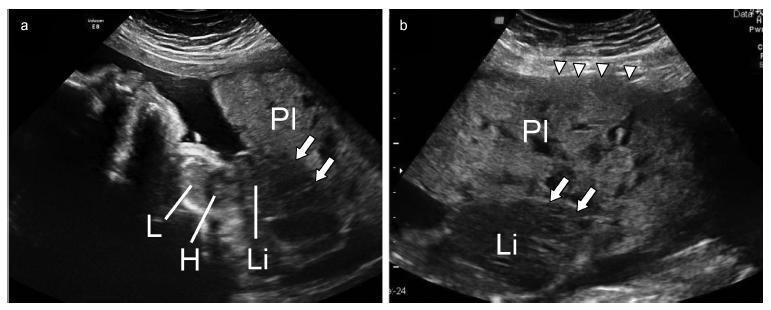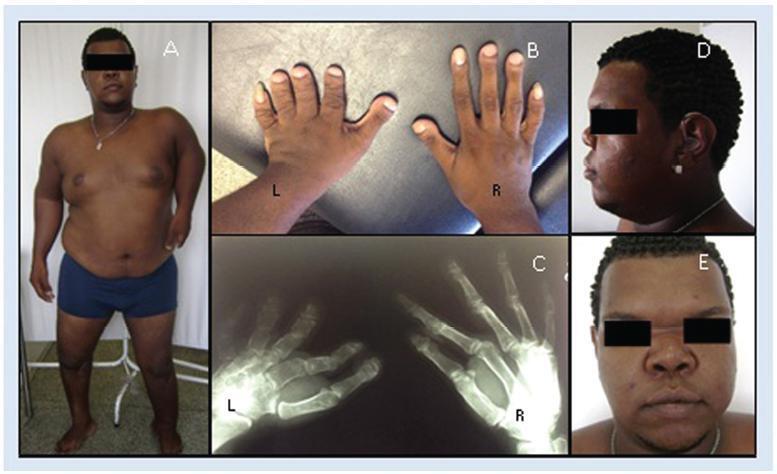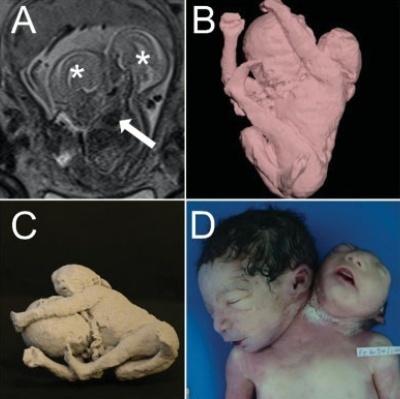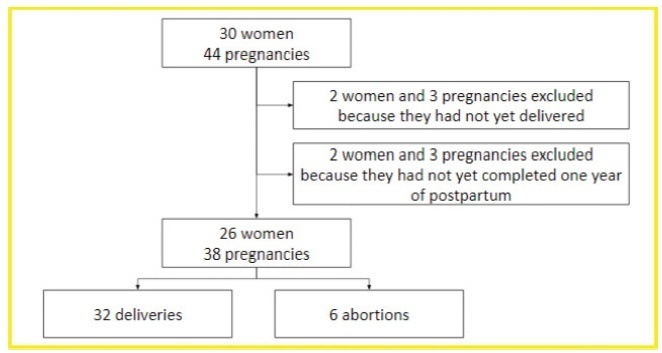-
Original Article08-04-2004
Why do we waste anti-D immunoglobulin in early miscarriage?
Revista Brasileira de Ginecologia e Obstetrícia. 2004;26(5):363-367
Abstract
Original ArticleWhy do we waste anti-D immunoglobulin in early miscarriage?
Revista Brasileira de Ginecologia e Obstetrícia. 2004;26(5):363-367
DOI 10.1590/S0100-72032004000500004
Views86See moreOBJECTIVE: evaluation of fetomaternal hemorrhage (FMH) in patients who would need Rh alloimmunization with anti-D immunoglobulin (300 mug) prophylaxis after early miscarriage. METHOD: we included in the study Rh (D) negative blood group patients with positive or unknown Rh (D) partners, who had had a miscarriage up to 12 weeks of gestation, and had been admitted to hospital for uterine curettage. After this procedure 5 ml of venous blood was collected from the patients and the rosette test was applied to screen which patients would need quantitative determination of fetal blood transferred to the maternal circulation, by the Kleihauer-Betke test (K-B). RESULTS: out of 26 patients evaluated the rosette test was positive in one , who showed an FMH of 1.5 ml in the K-B test. CONCLUSIONS: the dose of anti-D immunoglobulin used in cases of miscarriage up to 12 weeks of gestation should be substantially reduced. The availability of preparations of 50 mug is recommended, for a more inexpensive and rational treatment.
-
Original Article08-04-2004
Ductus venosus velocimetry: noninvasive identification of fetal acidemia in preterm fetuses with brain sparing reflex
Revista Brasileira de Ginecologia e Obstetrícia. 2004;26(5):355-361
Abstract
Original ArticleDuctus venosus velocimetry: noninvasive identification of fetal acidemia in preterm fetuses with brain sparing reflex
Revista Brasileira de Ginecologia e Obstetrícia. 2004;26(5):355-361
DOI 10.1590/S0100-72032004000500003
Views131See moreOBJECTIVE: to assess through Dopllerfluxometry the S/A ratio of the ductus venosus and determine the cut-off point to identify preterm fetuses with the ‘brain sparing phenomenon”. METHOD: a cross-sectional study was performed in 60 pregnant women that presented the “brain sparing phenomenon” (umbilical cerebral ratio >1) and gestational age between 25 and 33 weeks. The following parameters were studied: S/A ratio of the ductus venosus, pH and base excess (BE) of a fetal blood sample collected from the umbilical vein immediately after birth. The fetuses were classified according to the gas analysis result. They were considered abnormal when pH <7.20 and BE < -6 mmol/l. A receiver operator characteristic (ROC) curve analysis was performed to examine the relationship between S/A ratio and fetal acidemia. RESULTS: sixty pregnant women in the period of January 1998 to January 2003 were selected. In the moment of the study the gestational age varied from 25 to 33 weeks, with an average of 29.7 weeks (±1.8 weeks). All of the fetuses presented the "brain sparing phenomenon". Among them 14 presented abnormal gas analysis at birth and 46 presented normal gas analysis. The prevalence of fetuses with abnormal gas analysis in the studied material was 23.33%. Significant association was observed between the abnormal ductus venosus velocimetry and abnormal gas analysis at birth (chi2 = 784.44, p < 0.00001) in preterm fetuses with "brain sparing phenomenon". The best cut-off point of the S/A ratio (where the ROC curves bent) was 3.4. CONCLUSION: fetal acidemia in preterm fetuses with "brain sparing phenomenon" may be noninvasively identified by Doppler measurement of the ductus venosus when the S/A rises above 3.4.
-
Original Article08-04-2004
Prediction of fetal growth restriction by biometry of the transverse diameter of the cerebellum
Revista Brasileira de Ginecologia e Obstetrícia. 2004;26(5):349-354
Abstract
Original ArticlePrediction of fetal growth restriction by biometry of the transverse diameter of the cerebellum
Revista Brasileira de Ginecologia e Obstetrícia. 2004;26(5):349-354
DOI 10.1590/S0100-72032004000500002
Views89See moreOBJECTIVE: to evaluate the accuracy of both the transverse diameter of the cerebellum (TDC) and of the transverse diameter/abdominal circumference (TDC/AC) ratio in the detection of fetal growth restriction (FGR), in high-risk pregnancies. METHOD: a prospective cross-sectional study was carried out in 260 patients with gestational age between 28 and 40 weeks. The TDC and AC of fetuses were measured through ultrasound and the fetuses with TDC below the 10th percentile or TDC/AC ratio above the 90th percentile (>14.6) were classified as FGR suspects. After birth, the accuracy of the TDC and TDC/AC was evaluated using the neonatal diagnosis of FGR as the gold standard (birth weight <10th percentile). RESULTS: after birth, 79 newborns (30.4%) were classified as small for gestational age. The TDC was appropriate in 74 (93.7%) of these fetuses and small in only 5 (6.3%). The sensitivity (SE), specificity (SP), positive (PPV) and negative (NPV) predictive values and accuracy of the TDC in the prediction of FGR were 6.3, 93.4, 29.4, 69.5, and 67%, respectively. The TDC/AC >14.6 correctly identified 59 of the 79 growth-restricted fetuses, with 27 false-positives and 20 false-negatives, SE of 74.5%, SP of 85.1%, PPV of 68.6%, NPV of 88.5% and 81.9% accuracy. CONCLUSION: the TDC is not a good screening parameter for the detection of FGR while the TDC/AC ratio above the 90th percentile is effective in this detection.
-
08-04-2004
Os hospitais das universidades públicas brasileiras
Revista Brasileira de Ginecologia e Obstetrícia. 2004;26(5):347-347
-
Original Article07-22-2004
Rapid HIV testing in parturients
Revista Brasileira de Ginecologia e Obstetrícia. 2004;26(4):325-328
Abstract
Original ArticleRapid HIV testing in parturients
Revista Brasileira de Ginecologia e Obstetrícia. 2004;26(4):325-328
DOI 10.1590/S0100-72032004000400010
Views123OBJECTIVE: to evaluate the sensitivity and specificity of a rapid antibody HIV test (DetermineTM – Abott) for women in labor between August 1, 2001, and October 5, 2002. METHODS: all parturient women who had not been tested for the detection of HIV during pregnancy or had the result of an HIV test not available at admission were included in the present study. Blood samples were collected at the moment of admission, and the rapid test was carried out and compared with the gold standard (ELISA and Western blot). RESULTS: in 298 pregnant women assessed, the rapid test was positive in 16 (5.3%), and the results were confirmed by ELISA and Western blot in 12 cases (4%). All negative results were confirmed by the ELISA and Western blot tests. CONCLUSIONS: the test presented 100% sensitivity, 98% specificity, 75% positive predictive value, and 100% negative predictive value. These data show the importance of the rapid test for the detection of HIV infection in emergencies, such as imminent delivery of non-previously tested pregnant women.
Key-words HIV and pregnancyInfections in pregnancyRapid HIV testSIDA and pregnancyVertical transmissionSee more -
Original Article07-22-2004
Conventional urodynamics versus simplified cystometry for characterization of female urinary incontinence
Revista Brasileira de Ginecologia e Obstetrícia. 2004;26(4):311-316
Abstract
Original ArticleConventional urodynamics versus simplified cystometry for characterization of female urinary incontinence
Revista Brasileira de Ginecologia e Obstetrícia. 2004;26(4):311-316
DOI 10.1590/S0100-72032004000400008
Views90See moreOBJECTIVE: to assess the concordance of different urodynamic parameters with simplified cystometry, thus improving the cost-benefit relationship for stress urinary incontinence (SUI) diagnosis in woman. METHODS: we evaluated retrospectively the medical records of thirty patients treated, from January 2000 to March 2001. All patients had been submitted to physical and gynecological examinations. A conventional urodynamic study had been made using a Dynograph R-611 recorder. Simplified cystometry had used a saline tube with “Y” connector, connected to a Foley 14 Fr catheter, which allowed measurement of intra-vesical pressure at the same time as physiological saline infusion. The following parameters were analyzed: residual volume, bladder capacity, complacency, involuntary detrusor contractions, and abdominal leak-point pressure. The Pearson test of agreement and the Wilcoxon signed rank test were used to verify the concordance between related samples, with p < 0,05. RESULTS: the average age was 50 years old (28-70). Concordance between studies for stress urinary losses was 67%, and for detrusor involuntary contractions, 90%. The average residual volume was significantly different: by simplified cystometry it was 16.8 ml versus 2 ml by conventional urodynamics (p < 0.01). The average maximum vesical capacity by urodynamic study was 440.5 ml, and by simplified cystometry, 387 ml (p < 0.05). Vesical complacency was on average, significantly larger in simplified cystometry (43.0 ml/cmH2O) than in the urodynamic study (31.5 ml/cmH2O), with p < 0.01. CONCLUSION: preliminary evaluations suggest that the urogynecologic propedeutic associated with cystometry is an option to be considered in the clinical and preoperative assessment of patients with SUI instead of conventional urodynamics, particularly when the latter is not available. Simplified cystometry is an accessible exam that grants comparable results for the detection of involuntary detrusor contractions and for the identification of urinary loss, providing the examiner with trustworthy data on vesical behavior.
-
Thesis Abstract07-20-2004
Striated muscle histomorphometric study of rats in anestrus
Revista Brasileira de Ginecologia e Obstetrícia. 2004;26(4):336-336
Abstract
Thesis AbstractStriated muscle histomorphometric study of rats in anestrus
Revista Brasileira de Ginecologia e Obstetrícia. 2004;26(4):336-336
Search
Search in:
Tag Cloud
Pregnancy (252)Breast neoplasms (104)Pregnancy complications (104)Risk factors (103)Menopause (88)Ultrasonography (83)Cesarean section (78)Prenatal care (71)Endometriosis (70)Obesity (61)Infertility (57)Quality of life (55)prenatal diagnosis (51)Women's health (48)Maternal mortality (46)Postpartum period (46)Pregnant women (45)Breast (44)Prevalence (43)Uterine cervical neoplasms (43)









